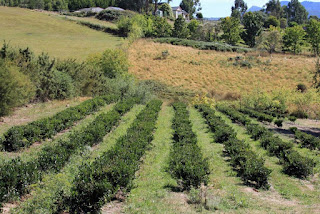Tasmania is known for its fine cool-climate wines, ciders and artisan spirits.
The Apple Isle is also well known for its apples, berries and cheeses, as well as more recent gourmet additions including avocado, wasabi and saffron.
Tasmania’s innovative producers are finding great success with unexpected crops, now including tea.
In the hills south of Hobart at Allens Rivulet, there’s a sight you would expect to see in Sri Lanka, or Darjeeling – a tea plantation, Brand Tasmania reports.
Not only is it the only tea plantation in Tasmania, but it’s also the most southerly one in the world.
What’s more, Tasmania’s pioneering tea farmers, scientists Jane and Dr Gordon Brown, are convinced there is great potential for tea to join the list of our valuable crops.
“Tasmania is an ideal place to grow tea,” Gordon says. “Currently there is a world shortage of tea and huge demand for the product. So yes, tea could become one of our important crops.”
After water, tea is the most widely consumed drink in the world, worth a staggering $US 50 billion each year.
China is the powerhouse producer, followed by India, where much of the crop is grown around Darjeeling in the Himalayan foothills.
“Most of the tea comes from high altitude areas in the tropics, where they get the same temperatures as Tasmania,” Gordon explains.
“If you look at Darjeeling for example, our temperature range is almost identical.
“But the biggest difference is rainfall, which is an advantage for us. Darjeeling can get up to 20ml of rain a day during their summer monsoons - which reduces the quality.”
The Browns planted their first tea crop in the mid 1990s using plants sourced from Japan.
They grow camellia sinensis, which is turned into both green and black tea, with all production on-site at their small farm.
Around 4,000 bushes now cover half a hectare, which produces 200 kilos every year.
The Browns’ tea adventure dates back to 1990 when Gordon – who has a master’s degree in agriculture and PhD in horticulture – was asked to research potential new Tasmanian crops, including tea, for the state Department of Agriculture.
“I fell in love with tea as a crop. It’s incredibly low risk, and extremely resilient,” he said.
“For example, if you grow cherries and it rains, you lose the crop and you have to wait another 12 months for your next one.
"With tea, the biggest risk is frost in the spring, but if you lose the crop, you have another one four weeks later.”
The Apple Isle is also well known for its apples, berries and cheeses, as well as more recent gourmet additions including avocado, wasabi and saffron.
Tasmania’s innovative producers are finding great success with unexpected crops, now including tea.
In the hills south of Hobart at Allens Rivulet, there’s a sight you would expect to see in Sri Lanka, or Darjeeling – a tea plantation, Brand Tasmania reports.
Not only is it the only tea plantation in Tasmania, but it’s also the most southerly one in the world.
What’s more, Tasmania’s pioneering tea farmers, scientists Jane and Dr Gordon Brown, are convinced there is great potential for tea to join the list of our valuable crops.
“Tasmania is an ideal place to grow tea,” Gordon says. “Currently there is a world shortage of tea and huge demand for the product. So yes, tea could become one of our important crops.”
After water, tea is the most widely consumed drink in the world, worth a staggering $US 50 billion each year.
China is the powerhouse producer, followed by India, where much of the crop is grown around Darjeeling in the Himalayan foothills.
“Most of the tea comes from high altitude areas in the tropics, where they get the same temperatures as Tasmania,” Gordon explains.
“If you look at Darjeeling for example, our temperature range is almost identical.
“But the biggest difference is rainfall, which is an advantage for us. Darjeeling can get up to 20ml of rain a day during their summer monsoons - which reduces the quality.”
The Browns planted their first tea crop in the mid 1990s using plants sourced from Japan.
They grow camellia sinensis, which is turned into both green and black tea, with all production on-site at their small farm.
Around 4,000 bushes now cover half a hectare, which produces 200 kilos every year.
The Browns’ tea adventure dates back to 1990 when Gordon – who has a master’s degree in agriculture and PhD in horticulture – was asked to research potential new Tasmanian crops, including tea, for the state Department of Agriculture.
“I fell in love with tea as a crop. It’s incredibly low risk, and extremely resilient,” he said.
“For example, if you grow cherries and it rains, you lose the crop and you have to wait another 12 months for your next one.
"With tea, the biggest risk is frost in the spring, but if you lose the crop, you have another one four weeks later.”



No comments:
Post a Comment